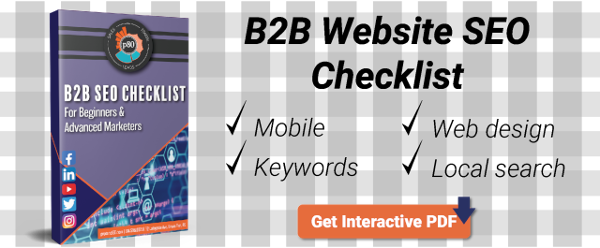Inbound Marketing Blog
for Manufacturers and Healthcare Companies
3 B2B Healthcare SEO Strategy Mistakes (& How to Cure Them)
.jpg?width=1200&name=Copy%20of%20Email%20Banner%20Text%20Template%20(1).jpg)
There’s nothing worse than putting effort into creating a website full of useful content, only to have it buried deep in the search engine results pages.
Small mistakes with SEO (search engine optimization) can have big consequences for how well a website and its individual pages perform. Bad SEO hampers your lead generation and your entire med tech marketing strategy.
We’ve pulled together the top 3 healthcare SEO mistakes marketers should avoid. Plus, we'll offer solutions if your healthcare website is victim to any of these errors.
Top 3 Healthcare SEO Mistakes (+ 1 Bonus Tip)
Most tech companies know by now that any digital marketing strategy must include SEO, whether they handle it in-house or hire an SEO agency. But when medical SEO marketing stagnates, it's usually for reasons like these:
- Choosing form over function
- Loading up on jargon
- Forgetting unique page titles
- ??? (see below)
1. Choosing Complicated Design Over Functionality
Your website’s design can affect its SEO.
Search engines look for basic construction techniques and usability best practices while indexing your site for users to find. If your site skimps on these aspects, your rankings will suffer.
Common website functionality issues that affect SEO include:
- Slow site speed from giant photo and video files being prioritized over text content
- Limited or nonexistent mobile device support
- Single-page sites with jump navigation and animations
The amount of time a visitor spends on your site also impacts SEO. Search engines like Google take note of how quickly someone leaves your site, and how many pages that person views before leaving. If visitors are quickly dissatisfied with your website, they’ll leave quickly -- whether it's because your site is painful to look at/use, or because it lacks helpful information.
On the aesthetic side, we’ve seen a website’s SEO hurt by:
- Font sizes too small or too large
- Long, boring blocks of text
- Odd color schemes
- Hilariously dated site design
How to Fix It:
If your website has most of these "features," it might be time to consider a total redesign -- one that’s clean and has only pertinent, customer-focused information.
If you only need a few changes or don't have the capability/time to overhaul your site, create a small checklist. Some quick fixes:
- Use fewer, yet meaningful photos (keeping file size reasonable)
- Use third-party services like YouTube to host your video files and embed them on your site
- Make text easily readable
- Use a website template that supports responsive design for mobile device

2. Using Too Much Jargon
While it might be tempting as a way to show off competency, website content heavy with jargon and technical terms (including acronyms) from your industry can work against you.
Nine times out of 10, jargon isn't user-friendly. Using too much jargon can push visitors away -- especially new ones.
Why?
Chances are your website’s visitors -- especially those in the Awareness stage of the buyer’s journey --- are unfamiliar with nuances of your industry. If they can’t understand what you’re talking about, they’ll probably look somewhere else for information.
If visitors leave your site quickly because they are having a rough time understanding it, a search engine will note that and can lower your site’s ranking.
How to Fix it:
Write to your audience. If you’re trying to attract prospects who are brand-new to your industry, keep the language and terminology easy enough to understand. Don’t make readers work to comprehend meaning.
3. Not Using Unique Page Titles
A website page title lets users and search engines understand the purpose of that page. For search engines, the page title is a key element in how websites are indexed for relevancy and show highly they appear in results for search queries.
Even the "expert" medical device/software marketing agencies sometimes forget to customize the page title. This simple oversight makes it that much more difficult for a search engine to recognize your page and direct people to it.
Untitled pages are often indexed as “Untitled document” -- a simple Google search turns up thousands of pages with that title. Seriously, check it out.
Of note, Google can also ding your blog for unoptimized SEO if your posts don't have separate H1s (blog post titles, basically) and titles (the page title that appears in search results).
How to Fix it:
Work on your titles! Accessing where your meta description lives depends on the platform you’re using to manage your site (HubSpot, WordPress, etc.). When you do get there, here are some tips for creating a website page title:
- Keep it short -- don’t go over 60 characters, or Google will cut it off on search results
- Make it relevant to the page’s content
- Use a long-tail keyword, preferably in the beginning
- On highly important pages (i.e. the homepage and your About Us page), include your company’s name
- Make it unique -- don’t use the same title for multiple pages on your website
Check out this Yoast article to learn more about separating your H1s and page titles (like on your blog).
Bonus Mistake:
This next mistake goes hand-in-hand with not using page titles.
A meta description is a short summary -- usually between 150-160 words -- of the contents of a webpage. You’ll see them in search results right underneath a page title. They’re great for enticing a searcher to click on your result over a competitor’s.
Just like with page titles, sometimes meta descriptions are neglected by in-house teams or even third-party medical device marketing companies. Without a meta description, search engines automatically pull content from your page to use as the description. You may not like what section of copy they pull, and worse, it may detract from visitors clicking through to your site.
We're feeling generous today, so here's a bonus to the bonus. Healthcare tech marketers also tend to forget about image alt text. Alt text is a back-end string of words used to describe an image on your page. If you don't add it:
- Vision-impaired visitors using screen readers won't be able to understand your image
- There will be no explanatory text to replace an image that fails to load
- Google will have a harder time understanding and indexing your image
How to Fix it:
Again, finding your meta description on the back end of your site depends on the platform on which your site runs. When you do get there, remember to:
- Write short, compelling copy
- Mention a benefit or solution found on the webpage
- Use the same keyword as your page's primary keyword
And remember to add alt text to every image on your site!
Ready to Learn More About Healthcare SEO?
Check out these additional resources on how to make the most of SEO for your healthcare tech marketing strategy:
- How to Turn Bad Website Traffic into Quality Leads Using SEO
- Inbound Marketing for Healthcare: Boost Traffic WITHOUT Pay-per-Click
For a more in-depth guide, check out our free, interactive checklist for healthcare technology marketing SEO:
(Editor's note: This article was originally published in April 2020 and was recently updated.)
Our Blogs, Direct to Your Inbox!
How to Audit your Online Marketing
If you are executing digital marketing, congratulations! You are most likely already one step ahead of your competition, and making strides to meaningfully connect with prospects online. But, how do you know if you’re seeing continual success year over year, and improving your metrics?
Without the tools in place to analyze and benchmark your efforts, it is impossible to scale your online marketing and ensure continuous success.




